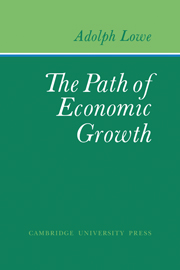Book contents
Appendix: An Alternative Presentation of Lowe's Basic Model
Published online by Cambridge University Press: 07 October 2011
Summary
INTRODUCTION
Adolph Lowe's Basic Model, on which he builds his analyses of various types of economic growth, is a new species of an increasingly familiar genus. Since the 1920s when Lowe first formulated his ideas, Sraffa, von Neumann, Joan Robinson, Samuelson, Hicks, Goodwin, and Morishima, to name but a few of the best known, have developed fixedcoefficient models for the analysis of capital accumulation and, thus, implicitly or explicitly, of economic growth. Lowe's book is an important reminder that these efforts have grown out of a long and still largely unappreciated tradition of nonneoclassical thinking in continental Europe between the two world wars.
The questions asked in this tradition, as well as the modes of analysis, differ significantly from the standard procedure of neoclassicism – a point that stands out clearly in the present work. Rather than studying the problems most prominent in recent discussions, such as pricing, income distribution, or the valuation of capital, Lowe is concerned with the almost totally neglected problem of the adjustment of a growing system using fixed-capital goods to a change in its parameters and, in particular, with the issue of “traverse” (Hicks) from a given to a higher or a lower rate of growth.
The purpose of this appendix is, first of all, to provide the basis for a comparison of Lowe's Basic Model of the structure of production and especially its technical foundations, with the framework of two other types of fixed-coefficient models most prominent in contemporary literature – the multisectoral models of von Neumann, Leontief, Sraffa, et al., on the one hand, and the two-sector models of Hicks, Spaventa, Good-win, and Morishima, on the other hand.
Information
- Type
- Chapter
- Information
- The Path of Economic Growth , pp. 289 - 326Publisher: Cambridge University PressPrint publication year: 1976
Accessibility standard: Unknown
- 1
- Cited by
